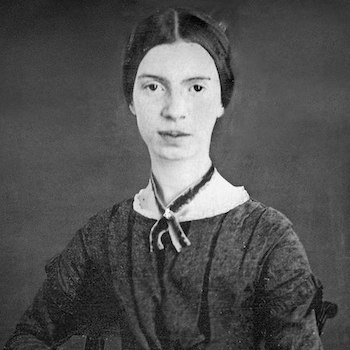Emily Dickinson Biographgy

Emily Elizabeth Dickinson was born on December 10, 1830 in Amherst, Massachusetts. Most of her work as a poet was hidden from her family and the surrounding community until after her death in 1886. Only ten poems out of the 1800 she wrote were published during her lifetime.
Dickinson was born into an influential and well-liked family in Amherst. Her grandfather, Samuel Dickinson, was responsible for founding Amherst College and for the construction of the family homestead. This large mansion in the center of Amherst would become the Dickinson family home for the next century.
Samuel Dickinson's son, Edward, was a lawyer who served the Hampshire district in the United States Congress and acted as the treasurer at Amherst College for over 40 years. He married Emily Norcross in 1828 and their union produced three children. Emily Elizabeth Dickinson was the middle child between her brother Austin and her younger sister Lavinia.
Samuel Dickinson reportedly took great interest in his children's education. Correspondence suggests Dickinson had a warm relationship with her father. The same cannot be said about her relationship with her mother which Dickinson described as pained and unloving. The family practiced evangelical Calvinism, and much of Dickinson's early years and education were dictated by the expectations of her faith.
The Dickinson children all attended the Amherst Academy. Teachers recognized Emily Dickinson's particular talent for composition. She showed aptitude in other key subjects at the academy such as botany.
Despite a promising start to her education Dickinson was unhappy after moving on to the Mount Holyoke Female Seminary. Strict rules and religious doctrine were unappealing to Dickinson and she returned home to live with her parents after only one year at the seminary. Calvinism dominated the belief of both her university and family life, but Dickinson never went through the faith's long-held ritual of conversion.
Despite refusing a conversion many elements of the Calvinist faith seemed to have informed Dickinson's creative work. Repeated themes of immortality and a romantic longing for truth are evident throughout her career. This influence is joined by shades of Protestant dogma and Transcendentalism which she observed in Ralph Waldo Emerson's work.
All of the poems Dickinson composed as a teenager were sent as correspondence to friends. She was heavily influenced by Reveries of a Bachelor: Or a Book of the Heart, an emotional collection of essays by Marvel. This popular work encouraged Dickinson to describe her solitary pursuits in romantically playful language.
The majority of the writing Dickinson completed in the next decade was included in letters. Her most popular correspondents were her brother Austin, and a collection of female friends including her future sister in law Susan Gilbert. The vast amount of existing material that exists shows that Dickinson wrote far more than her pen pals, and that she frequently suggested they were committing neglect by not responding in turn. A feeling of abandonment is a common theme running through Dickinson's letters.
As a young woman Dickinson was also inspired by the work of Ralph Waldo Emerson and Elizabeth Barrett Browning. She felt personally validated by Barrett Browning's success as a woman, and was particularly drawn to the poem Aurora Leigh which described a female poet.
Dickinson never married and began to restrict her trips out of the house in her twenties. Prior to this only one possible love affair was ever recorded when she traveled to Washington D.C. with her family and heard Charles Wadsworth preach. The married Presbyterian minister maintained correspondence with Dickinson for the rest of his life. After his death Dickinson described Wadsworth as her dearest friend.
After Dickinson's mother fell ill both Dickinson sisters began to focus solely on her care and pursuits within the home. Austin married Susan Gilbert and they moved with their children to a home nearby. Lavinia never married and remained in the Dickinson family home along with Dickinson though she was not prone to such reclusive habits as her sister.
In 1858 Dickinson began to organize her massive volumes of poetry into manuscript-books. Over the course of seven years she compiled about 800 poems into neat bundles. Her intent with this collection is unknown, but it seems likely she was readying her work to be published posthumously.
Of all her correspondents Susan Gilbert appears to have been the most frequently contacted. She offered Dickinson a receptive ear and hosted many social events which Dickinson occasionally attended. On one such social gathering Dickinson met Springfield Republican editor and publisher Samuel Bowles. Bowles was impressed by Dickinson's poetry, and published seven poems during her lifetime. Dickinson did not give consent for her work to be included, but more of her poems appeared in the Springfield Republican during her lifetime than in any other publication.
Dickinson's work from the 1850s and 1860s reveals the personal strife that plagued her and is usually interpreted as romantic confusion. In addition, she was influenced by the tragedy of the Civil War. She wrote to the writer Thomas Wentworth Higginson and enclosed four poems for his critical analysis. Their correspondence would last for years and seemed to be a particularly important motivation for Dickinson.
The last 15 years of Dickinson's life found her producing about 35 poems a year, and almost entirely restricting visits in or outside her home. The death of her parents, Wadsworth, and other pen pals affected Dickinson's health profoundly. Left feeling once again alone and abandoned she also suffered from painful aching and sensitivity in her eyes.
Emily Dickinson died in 1886 at the age of 55 after suffering a stroke. Her sister Lavinia found her books of poetry and began the process of making the poetry public. The first collection entitled Poems by Emily Dickinson was published in 1890 and was met with praise. Opinions regarding the poet's talents were mixed in the twentieth century, but today she is known as the predominant American poet of the 19th century.
